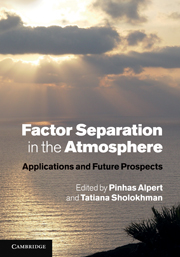Book contents
- Frontmatter
- Contents
- List of contributors
- Foreword
- Preface
- 1 Introduction
- 2 The Factor Separation Methodology and the fractional approach
- 3 Investigation of the Factor Separation features for basic mathematical functions
- 4 Factor Separation Methodology and paleoclimates
- 5 Meso-meteorology: Factor Separation examples in atmospheric meso-scale motions
- 6 Using the Alpert–Stein Factor Separation Methodology for land-use land-cover change impacts on weather and climate process with the Regional Atmospheric Modeling System
- 7 Application of Factor Separation to heavy rainfall and cyclogenesis: Mediterranean examples
- 8 Experience in applying the Alpert–Stein Factor Separation Methodology to assessing urban land-use and aerosol impacts on precipitation
- 9 Free and forced thermocline oscillations in Lake Tanganyika
- 10 Application of the Factor Separation Methodology to quantify the effect of waste heat, vapor and pollution on cumulus convection
- 11 The use of the Alpert–Stein Factor Separation Methodology for climate variable interaction studies in hydrological land surface models and crop yield models
- 12 Linear model for the sea breeze
- 13 Experience and conclusions from the Alpert–Stein Factor Separation Methodology
- 14 Tagging systematic errors arising from different components of dynamics and physics in forecast models
- 15 Some difficulties and prospects
- 16 Summary
- Appendix: References employing the Alpert–Stein Factor Separation Methodology
- References
- Index
Foreword
Published online by Cambridge University Press: 03 May 2011
- Frontmatter
- Contents
- List of contributors
- Foreword
- Preface
- 1 Introduction
- 2 The Factor Separation Methodology and the fractional approach
- 3 Investigation of the Factor Separation features for basic mathematical functions
- 4 Factor Separation Methodology and paleoclimates
- 5 Meso-meteorology: Factor Separation examples in atmospheric meso-scale motions
- 6 Using the Alpert–Stein Factor Separation Methodology for land-use land-cover change impacts on weather and climate process with the Regional Atmospheric Modeling System
- 7 Application of Factor Separation to heavy rainfall and cyclogenesis: Mediterranean examples
- 8 Experience in applying the Alpert–Stein Factor Separation Methodology to assessing urban land-use and aerosol impacts on precipitation
- 9 Free and forced thermocline oscillations in Lake Tanganyika
- 10 Application of the Factor Separation Methodology to quantify the effect of waste heat, vapor and pollution on cumulus convection
- 11 The use of the Alpert–Stein Factor Separation Methodology for climate variable interaction studies in hydrological land surface models and crop yield models
- 12 Linear model for the sea breeze
- 13 Experience and conclusions from the Alpert–Stein Factor Separation Methodology
- 14 Tagging systematic errors arising from different components of dynamics and physics in forecast models
- 15 Some difficulties and prospects
- 16 Summary
- Appendix: References employing the Alpert–Stein Factor Separation Methodology
- References
- Index
Summary
The Factor Separation method, pioneered in the now classic Stein and Alpert (1993) and Alpert et al. (1995) papers, provides a powerful, much-needed tool to assess both linear and nonlinear relationships among weather and climate forcings and feedbacks. As summarized in Chapter 1 of the book:
The FS method provides the methodology to distinguish between the pure influence of each and every factor as well as their mutual influence or synergies, which come into play when several factors, at least two, are “switched on” together. The understanding of which factor, or what combination of factors is most significant for the final result, is often very interesting in atmospheric studies. Discovering the most dominant factors in a specific problem can guide us to the important physical mechanisms and also to potential improvements in the model formulations.
Before this analysis procedure was introduced, numerical models usually performed sensitivity studies by turning on one forcing at a time, and used these results to decide what are the most important factors affecting a particular model simulation. However, we now recognize that such a linear type of analysis is incomplete and can even lead to the incorrect answer, as is illustrated in several chapters in this book.
This book provides a range of examples that illustrate the power of this analysis methodology for a range of spatial and temporal scales. The next step, besides applying the Alpert–Stein Factor Separation Methodology to additional atmospheric studies, should be to broaden it to include other geophysical disciplines.
- Type
- Chapter
- Information
- Factor Separation in the AtmosphereApplications and Future Prospects, pp. xiii - xivPublisher: Cambridge University PressPrint publication year: 2011



